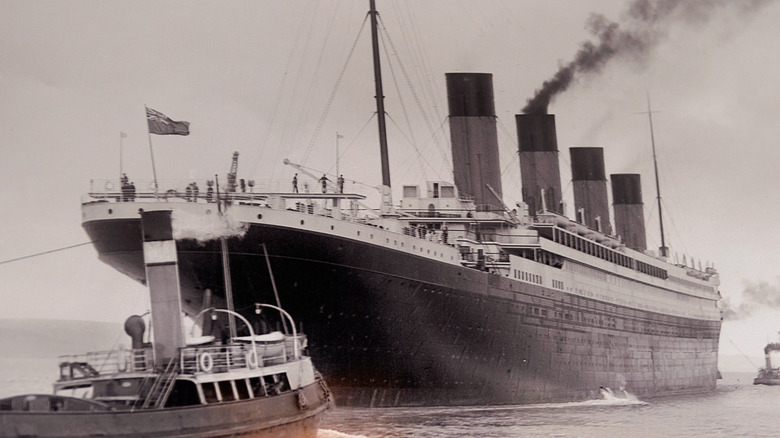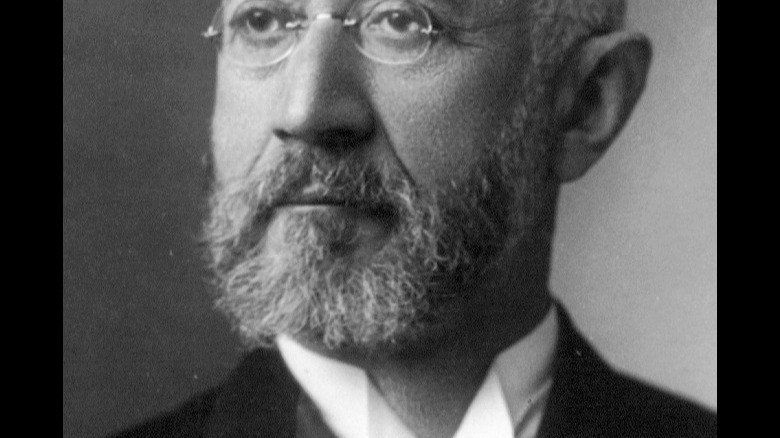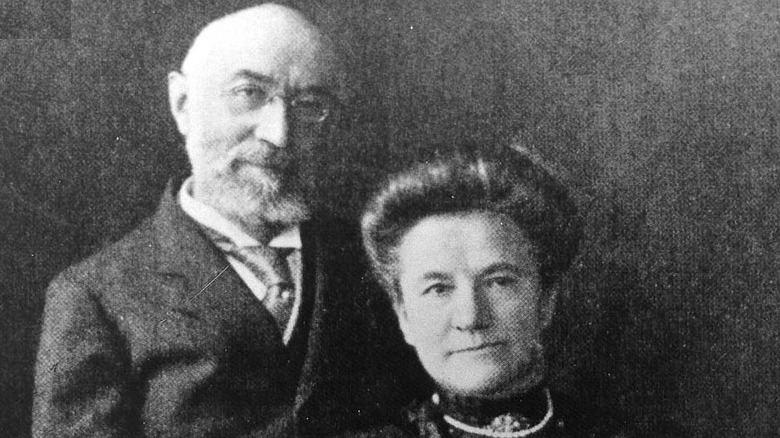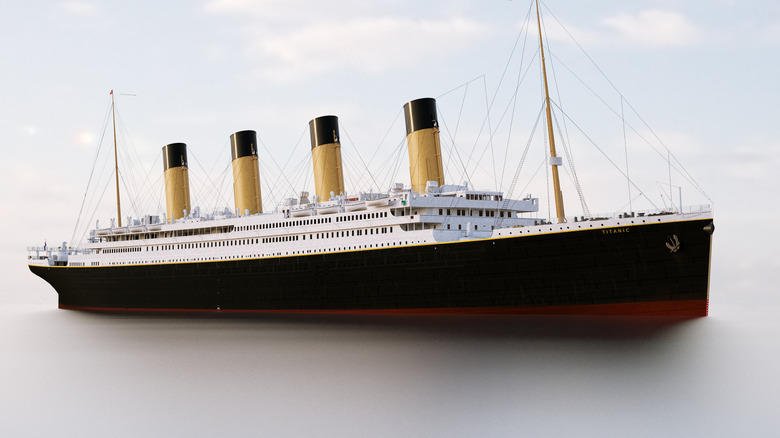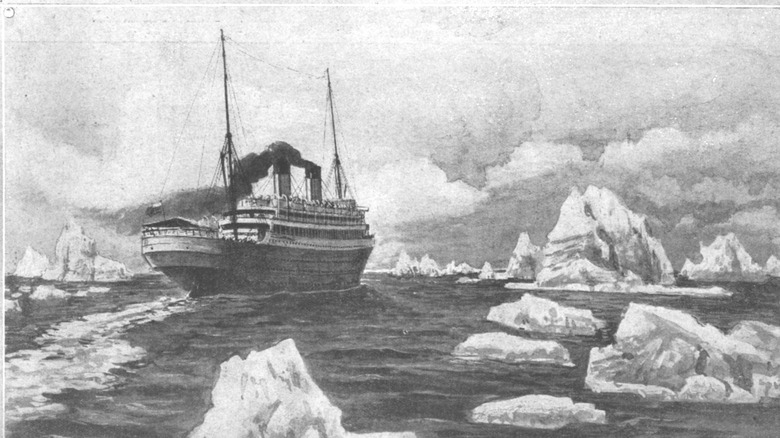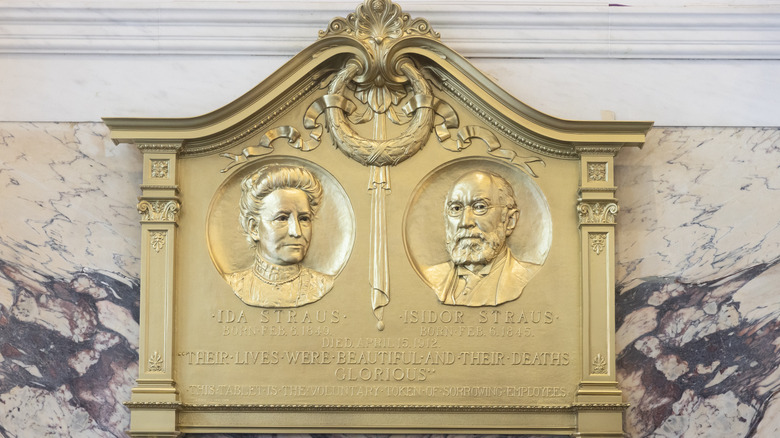The Tragic Story Of Isidor And Ida Straus Who Perished On The Titanic
In one of the more memorable scenes from James Cameron's 1997 blockbuster film "Titanic," a montage shows various passengers stoically accepting their fate as the waters in the sinking ship close in on them. In one particularly touching bit, the camera hovers over a bed in a first-class cabin, where an elderly man and woman embrace as the waters that will eventually kill them quickly rise. That man and woman were Cameron's nod to Isidor and Ida Straus, a wealthy American businessman and his wife, who were real passengers on the doomed ship. They refused special treatment and instead chose to die together.
That's not actually how they died, according to Historical Snapshots (they were last seen standing on the deck of the vessel), but the rest of their story is true. And in fact, so touching was the Straus' final act that (per "RisingTideFallingStar") witnesses called it a "most remarkable exhibition of love and devotion."
The co-owner of Macy's department store
You're undoubtedly familiar with the concept of rags to riches — when somebody comes from nothing and, through pluck and hard work, makes mountains of money. The story of Isidor Straus is not such a story.
According to the Straus Historical Society, Straus wasn't born poor, but he wasn't born rich either. His father was an itinerant merchant who moved the family a few times, but nevertheless, the elder Straus was successful. By the 1870s, Isidor and his brother, Nathan, were importing china, porcelain, glassware, and crockery and selling it from the basement of Macy's in New York City. Just over a decade later, the brothers were co-owners of the store along with the Macy family, and within another 11 years, the two men co-owned the store outright.
Beyond his status as a wealthy businessman, Isidor Straus also served in Congress, representing New York's 15th District, according to the House of Representatives website.
A love story for the ages
Isidor Straus lived and worked in a time when men of his wealth, status, and social station often womanized shamelessly and with few, if any, repercussions. This serial womanizing was probably helped by the fact that not all marriages between people in that social stratum were done for love — some were intended to strengthen alliances between families.
None of that seems to have applied to the marriage of Isidor Straus and Rosaline Ida Blun. As The Vintage News reports, whenever Isidor traveled on business, Ida accompanied him, the two seemingly enjoying each other's company wherever they went. Indeed, as one surviving letter from Ida reveals, she was distraught once when she learned that her husband would be coming home later from a trip than expected. "To say that I am disappointed in your not coming home tomorrow as your dispatch indicates hardly expresses my feelings," she wrote (per Chapter 16).
Fate puts them on the Titanic
Mr. and Mrs. Straus left New York for a winter holiday, much of it spent in Cape Martin in southern France (per The Vintage News). How and why they wound up aboard the supposedly "unsinkable" ship is a matter of dispute.
According to The National Archives (the British one, not the American one), Isidor would have preferred to sail on a German boat, but he was drawn by the allure of the Titanic, at the time the biggest, newest, and most luxurious ship that had ever been built. However, historian Tim Maltin claims on his blog that due to a coal miners' strike, coal was being diverted to the Titanic instead of other vessels so that the White Star Line ship could make its maiden voyage, as were passengers scheduled on other ships. Whether or not Mr. and Mrs. Straus were among those passengers who were to take a different ship but wound up on Titanic is not clear.
The Straus' refused special treatment
At 11:40 p.m. on the night of April 14, 1912, the Titanic struck an iceberg, sealing its fate (per CNN). A few hours later, the ship was below the water, and all but a small few of its passengers and crew who managed to make it into lifeboats died.
Paul A. Kurzman, great-grandson of Mr. and Mrs. Straus, told The Today Show in 2017 that his great-grandmother and -father were attempting to get into Lifeboat 8. Owing to the tradition of "women and children first," Mrs. Straus got in the boat, but Mr. Straus held back, only to be told by the sailor manning the boat that an exception would be made for him and that he could get on. He steadfastly refused, and Mrs. Straus, saying something not unlike "wherever you go, I will go" (accounts differ), left her seat on the boat.
James Cameron depicts the couple dying in their bed, seemingly having returned to their cabin, resigned to their fate. In fact, that's not what happened — accounts from survivors indicate that the couple was last seen standing on the deck of the ship.
The Straus' legacy
Two other people traveled with Isidor and Ida Straus on the Titanic, according to The National Archives. One was Isidor's manservant, John Farthing, and the other was Ida's maid, Ellen Bird. Bird made it into Lifeboat 8, and her mistress even gave her her mink coat — likely worth more than what she made in a year — to keep her warm on the boat (via The Today Show). Bird reportedly tried to return the coat to the Straus family after her rescue, but Ida's daughter Sara wouldn't allow it, telling her to keep it in her mother's memory.
Isidor's body was recovered, and along with it, a gold and onyx locket containing photographs — one of son Jesse, another of daughter Sara — that miraculously survived being exposed to saltwater. Ida's body was never recovered, nor was Farthing's. The Straus Mausoleum at Woodlawn Cemetery in the Bronx contains a cenotaph (an empty tomb) honoring the brave woman who refused to leave her husband's side, even in the face of certain death.
